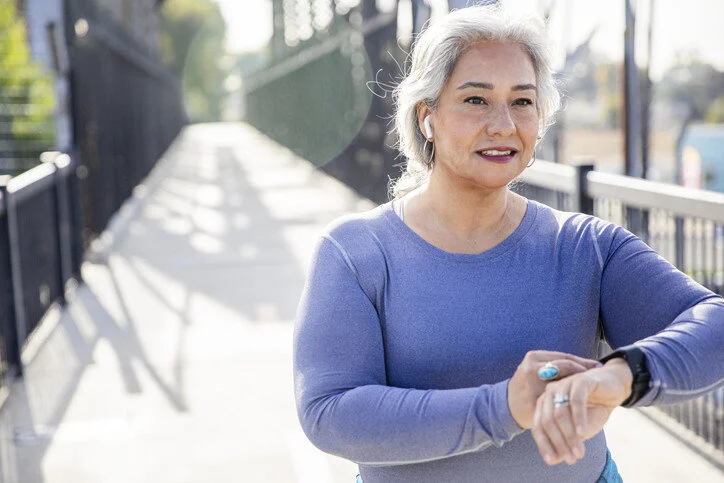An article from Harvard Health Publishing
June 09, 2021
By: Monique Tello, MD, MPH, Contributor
Science shows us that being physically active helps us feel better, and prevents or slows many diseases, including heart disease, cancer, and dementia. It even helps us live longer. For these reasons, the US physical activity guidelines and the American Heart Association recommend at least 150 minutes of moderate physical activity weekly. Now, a study in the British Journal of Sports Medicine suggests that routine activity may help protect people who get COVID-19 from becoming seriously ill.
Exercise as a vital sign
Healthcare providers at Kaiser Permanente, a large health care system in California, routinely ask all of their patients two simple questions about their physical activity. Together, they are called the "Exercise Vital Sign."
On average, how many days per week do you engage in moderate to strenuous exercise (like a brisk walk)? The answer choices are 0 to 7 days.
On average, how many minutes do you engage in exercise at this level? The answer choices are 0, 10, 20, 30, 40, 50, 60, 90, 120, 150 or greater minutes.
Research shows these questions measure people’s activity levels pretty well. They also predict some medical problems, such as high blood pressure and high blood sugar. Many health issues that are well associated with a lack of physical activity — such as overweight, obesity, diabetes, and heart disease — are also associated with greater risk of severe illness and death from COVID-19. But few studies directly investigated lack of physical activity as a possible risk factor.
How was this study done?
While the COVID-19 pandemic continues to rage in parts of the world, it is slowly retreating in the U.S. There are now three FDA-authorized vaccines, including one for children as young as 12. The vaccines are proving to be nearly as effective in the real world as they were in clinical trials. The CDC has relaxed some prevention measures, particularly for people who are fully vaccinated, and especially outdoors. Meanwhile, scientists continue to explore treatments and to keep an eye on viral variants.
The researchers analyzed anonymized data from more than 48,000 adults over 18 who had confirmed COVID-19 between January and October 2020. All had been patients at Kaiser Permanente for at least six months before testing positive for COVID-19, and had at least three Exercise Vital Sign measurements on file. Within this health system, 43% of patients are Latinx, 34% are white, about 11% are Black, and about 10% are Asian or Pacific Islander. The highest rates of COVID-19 were among those who were Latinx: 65% compared to 18% (whites), 7% (Blacks), and 6% (Asian or Pacific Islander).
The entire group was divided into three categories:
those who consistently met activity guidelines of over 150 minutes per week at all three measurements
those who were consistently inactive with only 0 to 10 minutes per week at all three measurements
those who were active in the range of 11 to 149 minutes per week, or who had variability in their three measurements.
The researchers also looked at other important characteristics of these 48,000+ patients. What was their age, sex, and race? Did they smoke or have emphysema? Did they have obesity (BMI 30 to 39) or severe obesity (BMI 40 or more), diabetes, high blood pressure, cardiovascular disease, or kidney disease? Were they immunocompromised for any reason? Had they gone to the emergency department or been hospitalized in the six months prior to COVID-19 diagnosis?
This is a lot of data to gather on the characteristics of individuals in a study. By putting this information into their analysis, researchers could calculate the risk associated with different outcomes and more clearly see how physical activity itself was associated with COVID-19 outcomes.
What did the researchers learn about physical activity and COVID-19?
What the researchers learned in this initial study was pretty remarkable, though further research to support the findings is necessary. Even after correcting for all of those characteristics, people who were consistently inactive had a significantly higher risk of hospitalization, ICU admission, and death after getting COVID-19 than those who were active for at least 150 minutes per week. Additionally, those who were active for over 10 minutes per week had some protection against severe illness or death from COVID-19 — though not as much as those who got the full 150 minutes. It’s worth noting that people who were white were somewhat more likely to meet physical activity guidelines — a discrepancy that should be acknowledged and addressed.
This study is one more reason to encourage and promote physical activity for everyone. Companies could provide gyms or fitness memberships, standing desks, and movement breaks. Government funding for bike lanes, walking paths, and pedestrian access would make it easier and safer to exercise. But set your own priorities, too: we can all commit to moving more! And next time you see your healthcare team, spend a few minutes talking about what might get you moving more. Would an exercise prescription help? Is there coaching available to help you set activity goals and achieve them? Does exercise hurt, or are you not sure how to get started?
Consistent physical activity helps protect you if you do get COVID-19. Of course, getting vaccinated offers much greater protection. Possibly doing both may be super-protective, although this needs to be studied. Meanwhile, we know that moving our bodies very day, even if it’s just walking, provides many benefits from head to toe. We as a society need to make it easy and safe for everyone to be as active as they can be.

